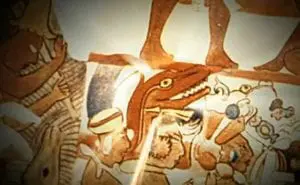Part 1
Are these beautiful birds in the above photograph essentially dinosaurs?
I’ve been spending time lately watching evolutionists’ videos purporting to document feathered dinosaurs found in the fossil record. Funny thing about this claim though: when you examine the photographs of the actual fossils featured in the videos… there are no indisputable feather impressions to be found! Maybe I simply have not watched the right videos yet to validate this claim?
Now, I have no particular bias against dinosaurs with feathers (for reasons I will elucidate below), and I can understand the appeal of the concept. Dinosaurs-with-feathers is a really cool and exotic concept and makes good subject matter for talented science-fiction artists seeking employment. Up until relatively recently, we have viewed dinosaurs as being bland and monotone in coloration like elephants or hippos. Wasn’t the tyrannosaurus rex in Jurassic Park monotone? The idea of dinosaurs sporting feathers is suggestive of rich and varied coloration like we see in many birds. Conceptually, this proposition is like living in the pre-color TV era and switching over to color TV. Who wouldn’t want dinosaurs to have feathers?


To go on a tangent for a moment, as far as coloration or pigmentation of dinosaurs is concerned the truth is apparently somewhere in between as the following Mayan depiction of a decapitated dinosaur head being offered to Mayan ruler Chaan Muan indicates. Note the bottom left portion of this Mayan mural (circa, 600 A. D.).

Do you see it? If not, look closer on the bottom of the mural in between the heads of the two Mayans all the way to the left. Better yet, here is a blowup of the relevant portion of the mural:

See it now? Note the size of the dinosaur head in comparison to the humans carrying it (i.e., this was a large creature, bigger than the humans carrying its head, and no mere lizard) and the realistic coloration of the skin tone of the Mayans. I would say this Mayan mural informs us of the coloration of at least one specimen of dinosaur. While not vividly colored like many birds, the dinosaur head depicted is not completely monotone either. I am not a dinosaur expert, but the depiction here appears to me to conform to what we know of theropods like the tyrannosaurus or perhaps a velociraptor. The theropods (upright, walking on two legs) are the specific dinosaurs evolutionists speculate as the ancestors of birds. Note well that there are no feathers to be seen in this Mayan dinosaur depiction, an apparently eyewitness depiction. (Images from Genesis Park website, www.genesispark.com.)
These supposed and proposed feathered dinosaurs are all the rage these days among evolutionists. It has become a real obsession for some evolutionists. The proposition that dinosaurs sported feathers has progressed from hypothesis to dogma among many (but certainly not all) evolutionists. The pro-feathered dinosaur faction, however, is the darling of the secular media and gets most of the press and the artistic magazine covers. The naysayers among the evolutionists are pretty much ignored and marginalized, even ostracized by some.
Yes, there is something there in the fossils, most likely fossilized collagen fibers left over after softer tissue decayed, but there are no clear, distinguishable feather impressions to be found. And one that did seem to have clear feather impressions, Scansoriopteryx, turned out to be a bird and not a dinosaur. Lesson to be learned: if it can be shown to have had feathers, the presumption is that it was a bird. The claim by evolutionists of feathered dinosaurs is clearly being driven by ideology and not by data. It is clear what the evolutionists are up to: they are attempting to validate dinosaur-to-bird evolution and any indistinct blur in the fossils will suffice as “fossil feathers” just fine, thank you. A bad fossil is better than no fossil at all!
As I noted in a previous article, evolutionists in general are mired down in what I have termed the “evolutionary placebo effect,” or, to coin another term, the Piltdown Syndrome, that is to say the phenomenon of being carried away in entirely subjective and biased interpretation of data. These evolutionists are being carried away like…well…feathers in the wind. Make no mistake about it, the proposition that dinosaurs had feathers is interpretation, not data. Even saying that is probably giving the evolutionists more credit than they deserve; we should probably simply regard this newest evolutionary dogma as wishful thinking and hopeful speculation.
Even if proof were unearthed in the form of a frozen and completely preserved dinosaur covered with feathers, this could not prove any organic relationship between dinosaurs and birds. It would simply mean God clothed dinosaurs with feathers as He did with birds. The whole dino-to-bird evolutionary hypothesis (based upon homology— I will get to that below) is fallacious, one assumption piled upon another. Any true discovery of dinosaurs with feathers would by no stretch of the imagination mean dinosaurs were the ancestors of birds any more than the fact that dinosaurs had eyes means they are the ancestors of birds. Feathered dinosaurs would not make me believe dinosaurs were the ancestors of birds any more than the existence of the duck-billed platypus makes me believe the platypus is descended from ducks.
Let’s get one other thing clear: we do not have any definitive empirical proof, one way or another, whether or not any dinosaurs sported feathers. I regard it as an exceedingly unlikely proposition but it is really quite irrelevant to the whole question of evolution, at best, or actually damaging to evolutionary ideology. Note well: in the “Dinosaurs had feathers” conjecture, the evolutionists are essentially making an argument from homology (same or similar body plan or features), actually assumed homology a la feathers, the discredited assumption that similar morphology implies ancestor-to-descedant relationship. (See my article regarding homology here.) This concept has completely failed evolutionists.
There is a very strong irony in this latest evolutionary article of faith. (Haman always gets hung in his own noose!) The argument for evolution based upon homology has, in fact, turned out to be an embarrassing Trojan Horse for evolutionists. Darwin, and evolutionists after him, had unwittingly accepted the Trojan Horse of homology into the academic courtyard, confidently expecting future biological discoveries on the microscopic level to mirror the homology evident on the macro scale.
This point is perhaps worth dwelling on and I will reiterate what I emphasized in my previous article. The proposition that homology (in this case feathered birds and presumably feathered dinosaurs) provides “landmarks” to chart “evolutionary progression” from one species to another also requires that this relationship must show up in genetics and embryology—but the genetics and embryology of similar creatures has turned out to be non-homologous! Homology is no problem for creationists. Homology is a problem for evolutionists because of its intelligent design implications but the dino-to-bird evolutionists seem oblivious to this fact. The feathered-dinosaur enthusiast is like a staggering drunk man stumbling in the middle of a busy highway oblivious to the truck about to run him over, indeed running toward its headlights as though it were illumination for his pathway.
Michael Denton quotes Sir Alister Hardy on the homology issue:
“The concept of homology is absolutely fundamental to what we are talking about when we speak of evolution—yet in truth we cannot explain it at all in terms of present day biological theory.”—pg. 151, Evolution: A Theory in Crisis, emph. supp.
The reason Hardy said homology could not be explained is because genetics and embryology do not mirror the homology we see on the macro level.The similarities have been arrived at through very different genetic and embryological pathways.
Denton comments:
“Homologous structures are often specified by non-homologous genetic systems and the concept of homology can seldom be extended back into embryology. The failure to find a genetic and embryological basis for homology was discussed by Sir Gavin de Beer, British embryologist and past Director of the British Museum of Natural History, in a succinct monograph Homology, an Unsolved Problem.”—pg. 145, emph. supp.
And,
“It appears that Darwin’s usage of the term ‘homology,’ which he defines in the Origin as ‘that relationship between parts which results from their development from corresponding embryonic parts’ is, as De Beer emphasizes, just what homology is not.
“The evolutionary basis of homology is perhaps even more severely damaged by the discovery that apparently homologous structures are specified by quite different genes in different species.”—pg. 149
And:
“Over and over again, as knowledge of invertebrate zoology has increased over the past two centuries, structures of astonishing similarity which were first thought to be homologous were later found to be only analogous. In botany, too, homologous resemblance has often had to be later reclassified as convergence, or analogy.”—pg. 153
Once this empirical fact is taken seriously, we are left with an astonishing outcome: homology, similar body plan and design in different species, is a real tangible fact of the biological world, yet we have no genetic basis to account for it consistent with common descent, nor embryological manifestation of it! There is no known natural reason for homology to exist, yet there it is staring us all in the face.
Evolutionists are loath to admit the obvious and inevitable conclusion: homology in living organisms is a powerful manifestation of intelligent design! In the homology of the living world we see conceptual design and common themes and hierarchical order, similarities in a way that automobiles or houses manifest the conceptual designs of their makers and are then translated into tangible similar objects. In the final analysis, homology is extremely damaging to evolutionary speculation and supportive of creationism. Nevertheless, evolutionists feel absolutely compelled to promote homology because it is so deeply rooted, indeed central to Darwinism, and entrenched historically in evolutionary speculation. Evolutionists are stuck with advocating homology as indicative of common descent whether they like it or not. I doubt if evolutionists will ever abandon the argument from homology. To do so means to concede that evolution has been falsified. They are tightly between a rock and a hard place on the issue of homology.
The evolutionists who are pursuing this line of argumentation in the feathered-dinosaurs-to-birds speculation have not come to terms with the true import of homology, with what Sir Gavin de Beer called the “unsolved problem” of homology. Let no evolutionist advocating an argument based upon homology pull the wool over anyone’s eyes. It bears repeating: homology is, indeed, a problem for evolutionists, not creationists, and the homology we see on the macro level has been definitively debunked as an argument in favor of evolution, and is indicative of intelligent design.
Homology–in this case (supposed) feathered dinosaurs–would simply add another argument for design to the creationist arsenal. I say let the feathered dinosaur fanatics continue in their folly. They know not what they say. The evolutionists claiming that dinosaurs sported feathers are digging themselves into a deeper and deeper pit in this endeavor, blissfully unaware of the significance of their proposition, presuming its significance to be the precise opposite of what it is. Many evolutionists are stuck in a pre-1950’s level of knowledge and understanding regarding the role of homology (partly the result of extreme specialization among scientists) and are well advised to consult Gavin De Beer on this subject, as well as Michael Denton in Evolution: A Theory in Crisis. Their ignorance at this late date of the significance of homology to the subject of evolution indicates the degradation of the whole institutional endeavor of evolutionism. The evolutionists are arguing against themselves. What we are witnessing in this feathered dinosaur frenzy is the disintegration of Darwinism, a slow suicide, happening before our very eyes.
The feathered dinosaur proposition is just one more evolutionary fraud.
In Part 2, we will look at an outright hoax of evolution, a purported feathered dinosaur, the famous archaeoraptor hoax, perpetrated on the public (knowingly) by National Geographic magazine.








This is a great article and I’m glad I read it! I was just watching a documentary about birds where the narrator confidently asserted that birds evolved from dinosaurs. Of course, he offered it like a fact and provided no proof for his statement. This article nails it for me. Genetics say otherwise. Thanks so much for making this information available!
Thank you, Jennifer. Yes, it CANNOT be overstated how SWEEPING a refutation of evolution the genetics-homology consideration really is. The failure of homology to be correlated back through any homologous genetic pathway is utterly and completely devastating to ALL evolutionary hypotheses. This aspect DEFINITIVELY falsifies evolution all by itself–by ANY proposed mechanism, whether Darwinian gradualism, punctuated equilibrium, vitalism, or supposed Divinely guided evolution. By any proposed METHOD, we would expect common descent of living organisms to be reflected in homologous genetic systems. But this we do not see. The debate is really over for any reasonable person. Evolutionists will continue, of course, in their blind faith, no matter what the empirical data plainly tells us.
Very well written article. It should have every evolutionary scientists squirming in their seats, although, I’m sure it won’t. It’s almost as if the evolutionist quotes an unproven theory enough times, if it’s repeated often enough by his equally clueless peers, it somehow becomes a proven fact. As if consensus has replaced real investigative, experimental science.
Thank you, Bradley for your feedback. Yes, the evolutionists keep banging the drum of how a “consensus” of scientists believe in evolution. Of course, the evolutionists DEFINE anyone who does not believe in evolution as “not a real scientist,” so, by their reckoning, 100% of all scientists believe in evolution. See how simple it is to determine the numbers? Thus, they simply DEFINE their problem out of existence. This is a self-assuring method of self-deception but it is hardly a rational way to determine what the real breakdown is. In any event, if we are counting heads (not that majorities determine anything by being a majority), the numbers are vastly SKEWED anyway because HUGE numbers of evolution doubters HIDE their true opinions for fear of losing their jobs and of being blacklisted. Just ask Mark Armitage or Guillermo Gonzalez, or Caroline Crocker. I can see it now: a poll is taken on the question and the pollster asks, “Do you believe in evolution?…and, oh, by the way…if the answer is yes, you’re fired.” Determining real numbers in academia, research, and government is currently impossible because of the persecution that exists against Darwin doubters.
Some of the past depictions of dragons sported feathers, however the secularist descriptions of them make them sound as if these were amalgamations or chimeras
of various animals, including birds, and therefore entirely mythical. I did a search, but could not determine if there were any depictions of dragons with feathers that in other respects matched known dinosaurs. It would be VERY interesting if some of the theropods secularists claim had feathers turned out to match historical depictions of feathered dragons — it would add yet another nail to the coffin of the evolutionary idea that dinosaurs and humans never co-existed!
Thank you, Dianne, for your response. My article here is from June of 2016. Ironically (providentially?) it was almost exactly one year to the day later that the Journal, “Science,” published an online article titled “World’s only fossils of T. rex skin suggest it was covered in scales—not feathers,” (http://www.sciencemag.org/news/2017/06/world-s-only-fossils-t-rex-skin-suggest-it-was-covered-scales-not-feathers) . The writer recounts the various tyrannosuars of which we have fossilized skin impressions and notes that “if these large tyrannosaurs had any feathers at all, says the team, their fluff would have been limited to their backs—the only body part for which they were lacking fossil impressions.” Follow the link and note the photo of the scaly tyrannosaur skin impression. THAT is what theropod skin looked like, not the feathery science-fiction we are routinely propagandized with. Propaganda, unfortunately, permeates evolutionary publications and visual media. Another one (which keeps popping up continually in new venues as if were a brand new find) is the bony bird tail encased in amber found in China. The evolutionists are pawning this off to the public as a dinosaur tail with feathers based upon the misconception that a bony tail means it was a dinosaur. Archaeopteryx, which most paleontologists now admit was a true flying-perching bird, also had a bony tail with feathers, so the only thing new in the Chinese find is the amazing degree of preservation of the specimen. The Chinese feathered tail came from a BIRD.